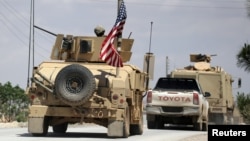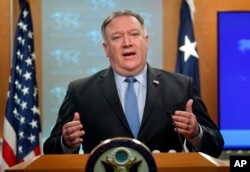More than two weeks after U.S. President Donald Trump declared victory over the Islamic State terror group in Syria and announced the withdrawal of U.S. forces, military planners are insisting the pullout be based on conditions on the ground and not an arbitrary timeline.
"Any plan we implement is going to be conditions-based," a U.S. defense official told VOA on Friday, insisting the pullout would be "heavily coordinated" with allies and partners.
"We're not going to discuss timelines," the official said.
Just hours earlier, senior State Department officials said that despite the president's directive, there was still no road map for bringing about 2,000 U.S. troops in Syria back home.
"We have no timeline for our military forces to withdraw from Syria," a senior State Department official told reporters Friday, ahead of a trip by U.S. Secretary of State Mike Pompeo to the Middle East next week.
"We are formulating the plans to do that right now," the official added. "It will be done in a deliberate, heavily coordinated way with our allies and partners."
The statements came two days after Trump shot down reports that the U.S. military was planning for all 2,000 U.S. troops in Syria, aiding in the fight against IS, to come home within four months.
"We're getting out very powerfully," Trump told reporters Wednesday during a meeting of his Cabinet. "I never said fast or slow.
"I don't want to be in Syria forever. It's sand and it's death," he added.
The latest comments represented a striking change in tone from the messaging that came from the White House when the president announced his decision to withdraw last month.
"Our boys, our young women, our men, they're all coming back and they're coming back now," Trump said in a video posted on his Twitter feed Dec. 19.
The decision caught officials — both in the U.S. and with U.S. allies and partners — by surprise, and ultimately led to the resignation of Defense Secretary Jim Mattis.
Despite the initial uproar, just five days later a U.S. defense official confirmed the process was officially under way.
"The execute order for Syria has been signed," the official said, refusing to provide additional details, citing operational security.
But since then, there have been few signs of any letup in the U.S. effort to support forces battling the Islamic State group.
The U.S.-led coalition Friday announced it had carried out 469 airstrikes against IS positions in Syria from Dec. 16 to Dec. 29, targeting hundreds of IS tactical units, fighting positions, supply routes and storage facilities.
In the prior two-week period, before Trump's announcement, the coalition carried out 459 strikes against IS positions, the vast majority of them in Syria.
"The OIR [Operation Inherent Resolve] mission has not changed," Pentagon spokesman Cmdr. Sean Robertson said. "We will continue to work with partners and allies to ensure the enduring defeat of ISIS through sustaining military gains and promoting regional security and stability."
Already, talks have been under way with Turkish officials about how and when U.S. troops will leave Syria. And those discussions are expected to intensify in the coming days during a visit to Turkey by key U.S. officials.
Upcoming trips
U.S. national security adviser John Bolton on Friday departed the U.S. with Ambassador James Jeffrey, special representative for Syria engagement, and Joint Chiefs Chairman Gen. Joseph Dunford for talks in Turkey and Israel.
On Friday, Jeffrey was also tapped to take over as the U.S. special envoy for the Global Coalition to Defeat IS.
The aim of the trip is "to discuss the withdrawal of U.S. forces from Syria, how we will work with allies & partners to prevent the resurgence of ISIS," Bolton tweeted, using an acronym for the militant group.
Pompeo also will seek to reassure jittery U.S. allies when he travels to the region next week, with stops in Egypt, Jordan and Saudi Arabia.
"They're going to have a challenge now going overseas and having their discussion partners believing that what they say is U.S. policy," said David Adesnik, the director of research at the Washington-based Foundation for Defense of Democracies.
But Adesnik said the inconsistent and disoriented messaging from the White House over the past few weeks, at times contradicting top defense and security officials, was just one obstacle.
The other is that allies and adversaries alike may now be more likely to put off any decisions or agreements until after the U.S. withdraws entirely, in line with Trump's stated wishes.
"You can basically wait it out," Adesnik said. "That's what everybody's going to do now. They know the game."
For now, U.S. officials are doing what they can to convince regional players that is not the case.
"Our military posture in Syria may be changing, but our overall goals in Syria remain the same," the senior State Department official said Friday.
"We do not intend to have an indefinite military presence in Syria," the official said. "We will be leaving in such a way that we do not open up vacuums for terrorists to exploit and that we don't allow for the possibility of a resurgence of ISIS anywhere."
U.S. officials said allies should also know that Washington will not be easing up on Iran, but instead will use other tools to ensure all Iranian-commanded forces leave Syria.
"The United States is not leaving the Middle East," a second senior State Department official said, calling reports the U.S. is abandoning the region a "false narrative."










